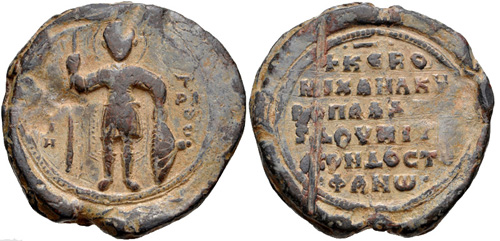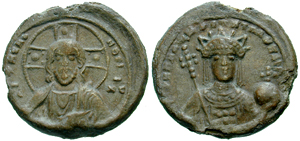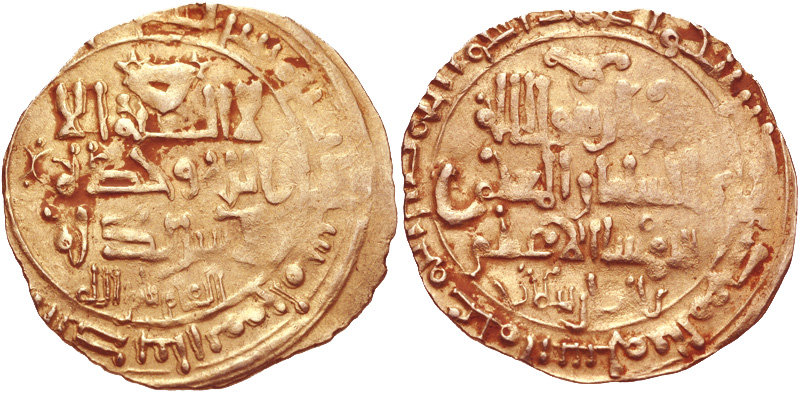|
Manuel Komnenos (kouropalates)
Manuel Komnenos (; – 17 April 1071) was a Byzantine aristocrat and military leader, the oldest son of John Komnenos and brother of the future emperor Alexios I Komnenos. A relative by marriage of Emperor Romanos IV Diogenes, he was placed in charge of expeditions against Turkish raids from 1070, until his sudden death by illness in April 1071. Origin and marriage Manuel was the first-born child of John Komnenos and his wife Anna Dalassene. The date of his birth is unknown, but he was described as a youth in 1068, so he must have been born around 1045. As a child, as was customary for children of the Byzantine aristocracy, Manuel was trained in war by his father, who at the time was (commander-in-chief) of the eastern field army. In 1057, his uncle, Isaac I Komnenos, became emperor, but abdicated in 1059 and was succeeded by Constantine X Doukas () after Manuel's father refused to take the throne. Manuel's mother, Anna Dalassene, refused to acquiesce to her husband's deci ... [...More Info...] [...Related Items...] OR: [Wikipedia] [Google] [Baidu] |
Kouropalates
''Kouropalatēs'', Latinized as ''curopalates'' or ''curopalata'' ( el, κουροπαλάτης, from lat, cura palatii "he one incharge of the palace"). and Anglicized as curopalate, was a Byzantine court title, one of the highest from the time of Emperor Justinian I to the Komnenian period in the 12th century.. The female variant, held by the spouses of the ''kouropalatai'', was ''kouropalatissa''. History and nature of the title The title is first attested (as ''curapalati'') in the early 5th century, as an official of ''vir spectabilis'' rank under the ''castrensis palatii'', charged with the maintenance of the imperial palace (cf. Western European "majordomo"). When Emperor Justinian I () made his nephew and heir Justin II ''curopalates'' in 552, however, the office took on new significance, and became one of the most exalted dignities, ranking next to ''Caesar'' and ''nobilissimus'' and, like them, reserved initially for members of the imperial family. Unlike them, however, ... [...More Info...] [...Related Items...] OR: [Wikipedia] [Google] [Baidu] |
Protostrator
''Prōtostratōr'' ( el, πρωτοστράτωρ) was a Byzantine court office, originating as the imperial stable master. Its proximity to the imperial person led to a highly visible role in imperial ceremonies, and served as a springboard for several capable individuals, like Manuel the Armenian or the future emperors Michael II and Basil I the Macedonian, to reach the highest offices. From the mid-11th century, the post rose in importance, becoming more an honorific dignity for senior members of the court, than an actual office. From the 13th century on, the post could be held by several persons, and ranked eighth in the overall hierarchy of the court. Throughout its history, it was a title often borne by senior military commanders. The female form of the title, given to the wives of the ''prōtostratores'', was ''prōtostratorissa'' (πρωτοστρατόρισσα). History and evolution The title means "first ", reflecting the office's initial nature as chief of the impe ... [...More Info...] [...Related Items...] OR: [Wikipedia] [Google] [Baidu] |
Irene Doukaina
Irene Doukaina or Ducaena ( el, , ''Eirēnē Doukaina''; – 19 February 1138) was a Byzantine Greek empress by marriage to the Byzantine emperor Alexios I Komnenos. She was the mother of Emperor John II Komnenos and the historian Anna Komnene. Life Irene was born in 1066 to Andronikos Doukas and Maria of Bulgaria, granddaughter of Ivan Vladislav of Bulgaria. Andronikos was a nephew of Emperor Constantine X Doukas and a cousin of Michael VII. Succession of Alexios Irene married Alexios in 1078, when she was still eleven years old. For this reason, the Doukas family supported Alexios in 1081, when a struggle for the throne erupted after the abdication of Nikephoros III Botaneiates. Alexios' mother, Anna Dalassene, a lifelong enemy of the Doukas family, pressured her son to divorce the young Irene and marry Maria of Alania, the former wife of both Michael VII and Nikephoros III. Irene was in fact barred from the coronation ceremony, but the Doukas family convinced the Pat ... [...More Info...] [...Related Items...] OR: [Wikipedia] [Google] [Baidu] |
Monastery Of Christ Philanthropos
A monastery is a building or complex of buildings comprising the domestic quarters and workplaces of monastics, monks or nuns, whether living in communities or alone (hermits). A monastery generally includes a place reserved for prayer which may be a chapel, church, or temple, and may also serve as an oratory, or in the case of communities anything from a single building housing only one senior and two or three junior monks or nuns, to vast complexes and estates housing tens or hundreds. A monastery complex typically comprises a number of buildings which include a church, dormitory, cloister, refectory, library, balneary and infirmary, and outlying granges. Depending on the location, the monastic order and the occupation of its inhabitants, the complex may also include a wide range of buildings that facilitate self-sufficiency and service to the community. These may include a hospice, a school, and a range of agricultural and manufacturing buildings such as a barn, a forge, ... [...More Info...] [...Related Items...] OR: [Wikipedia] [Google] [Baidu] |
Typikon
A typikon (or ''typicon'', ''typica''; gr, , "that of the prescribed form"; Slavonic: Тvпико́нъ ''Typikonə'' or Оуставъ, ''ustavə'') is a liturgical book which contains instructions about the order of the Byzantine Rite office and variable hymns of the Divine Liturgy. Historical development Cathedral Typikon The ancient and medieval cathedral rite of Constantinople, called the "asmatikē akolouthia" ("sung services"), is not well preserved and the earliest surviving manuscript dates from the middle of the eighth century.As quoted in Taft, "Mount Athos...", Description in A. Strittmatter, "The 'Barberinum S. Marci'of Jacques Goar," EphL 47 (1933), 329-67 This rite reached its climax in the Typikon of the Great Church (Hagia Sophia) which was used in only two places, its eponymous cathedral and in the Basilica of Saint Demetrios in Thessalonica; in the latter it survived until the Ottoman conquest and most of what is known of it comes from descriptions in ... [...More Info...] [...Related Items...] OR: [Wikipedia] [Google] [Baidu] |
Monastery
A monastery is a building or complex of buildings comprising the domestic quarters and workplaces of monastics, monks or nuns, whether living in communities or alone (hermits). A monastery generally includes a place reserved for prayer which may be a chapel, church, or temple, and may also serve as an oratory, or in the case of communities anything from a single building housing only one senior and two or three junior monks or nuns, to vast complexes and estates housing tens or hundreds. A monastery complex typically comprises a number of buildings which include a church, dormitory, cloister, refectory, library, balneary and infirmary, and outlying granges. Depending on the location, the monastic order and the occupation of its inhabitants, the complex may also include a wide range of buildings that facilitate self-sufficiency and service to the community. These may include a hospice, a school, and a range of agricultural and manufacturing buildings such as a barn, a fo ... [...More Info...] [...Related Items...] OR: [Wikipedia] [Google] [Baidu] |
Ear Infection
Otitis is a general term for inflammation or infection, inner ear infection, middle ear infection of the ear, in both humans and other animals. When infection is present, it may be viral or bacterial. When inflammation is present due to fluid build up in the middle ear and infection is not present it is considereOtitis media with effusion It is subdivided into the following: * ''Otitis externa'', external otitis, or "swimmer's ear", involves the outer ear and ear canal. In external otitis, we see tenderness in the pinna—i.e., the outer ear hurts when touched or pulled. * ''Otitis media'', or middle ear infection, involves the middle ear. In otitis media, the ear is infected or clogged with fluid behind the ear drum, in the normally air-filled middle-ear space. This is the most common infection and very common in babies below 6 months. This condition sometimes requires a surgical procedure called ''myringotomy'' and tube insertion. * ''Otitis interna'', or labyrinthitis, involv ... [...More Info...] [...Related Items...] OR: [Wikipedia] [Google] [Baidu] |
Bithynia
Bithynia (; Koine Greek: , ''Bithynía'') was an ancient region, kingdom and Roman province in the northwest of Asia Minor (present-day Turkey), adjoining the Sea of Marmara, the Bosporus, and the Black Sea. It bordered Mysia to the southwest, Paphlagonia to the northeast along the Pontic coast, and Phrygia to the southeast towards the interior of Asia Minor. Bithynia was an independent kingdom from the 4th century BC. Its capital Nicomedia was rebuilt on the site of ancient Astacus in 264 BC by Nicomedes I of Bithynia. Bithynia was bequeathed to the Roman Republic in 74 BC, and became united with the Pontus region as the province of Bithynia et Pontus. In the 7th century it was incorporated into the Byzantine Opsikion theme. It became a border region to the Seljuk Empire in the 13th century, and was eventually conquered by the Ottoman Turks between 1325 and 1333. Description Several major cities sat on the fertile shores of the Propontis (which is now known as Sea of Marma ... [...More Info...] [...Related Items...] OR: [Wikipedia] [Google] [Baidu] |
Constantinople
la, Constantinopolis ota, قسطنطينيه , alternate_name = Byzantion (earlier Greek name), Nova Roma ("New Rome"), Miklagard/Miklagarth (Old Norse), Tsargrad ( Slavic), Qustantiniya (Arabic), Basileuousa ("Queen of Cities"), Megalopolis ("the Great City"), Πόλις ("the City"), Kostantiniyye or Konstantinopolis ( Turkish) , image = Byzantine Constantinople-en.png , alt = , caption = Map of Constantinople in the Byzantine period, corresponding to the modern-day Fatih district of Istanbul , map_type = Istanbul#Turkey Marmara#Turkey , map_alt = A map of Byzantine Istanbul. , map_size = 275 , map_caption = Constantinople was founded on the former site of the Greek colony of Byzantion, which today is known as Istanbul in Turkey. , coordinates = , location = Fatih, İstanbul, Turkey , region = Marmara Region , type = Imperial city , part_of = , length = , width ... [...More Info...] [...Related Items...] OR: [Wikipedia] [Google] [Baidu] |
Alp Arslan
Alp Arslan was the second Sultan of the Seljuk Empire and great-grandson of Seljuk, the eponymous founder of the dynasty. He greatly expanded the Seljuk territory and consolidated his power, defeating rivals to the south and northwest, and his victory over the Byzantines at the Battle of Manzikert, in 1071, ushered in the Turkoman settlement of Anatolia. "But the Battle of Manzikert opened Asia Minor to Turkmen conquest" For his military prowess and fighting skills, he obtained the name ''Alp Arslan'', which means "Heroic Lion" in Turkish. Early life Alp Arslan was the son of Chaghri and nephew of Tughril, the founding Sultans of the Seljuk Empire. His grandfather was Mikail, who in turn was the son of the warlord Seljuk. He was the father of numerous children, including Malik-Shah I and Tutush I. It is unclear who the mother or mothers of his children were. He was known to have been married at least twice. His wives included the widow of his uncle Tughril, a Kara-Khanid pr ... [...More Info...] [...Related Items...] OR: [Wikipedia] [Google] [Baidu] |
Sultan
Sultan (; ar, سلطان ', ) is a position with several historical meanings. Originally, it was an Arabic abstract noun meaning "strength", "authority", "rulership", derived from the verbal noun ', meaning "authority" or "power". Later, it came to be used as the title of certain rulers who claimed almost full sovereignty (i.e., not having dependence on any higher ruler) without claiming the overall caliphate, or to refer to a powerful governor of a province within the caliphate. The adjectival form of the word is "sultanic", and the state and territories ruled by a sultan, as well as his office, are referred to as a sultanate ( '. The term is distinct from king ( '), despite both referring to a sovereign ruler. The use of "sultan" is restricted to Muslim countries, where the title carries religious significance, contrasting the more secular ''king'', which is used in both Muslim and non-Muslim countries. Brunei and Oman are the only independent countries which retain the ti ... [...More Info...] [...Related Items...] OR: [Wikipedia] [Google] [Baidu] |








